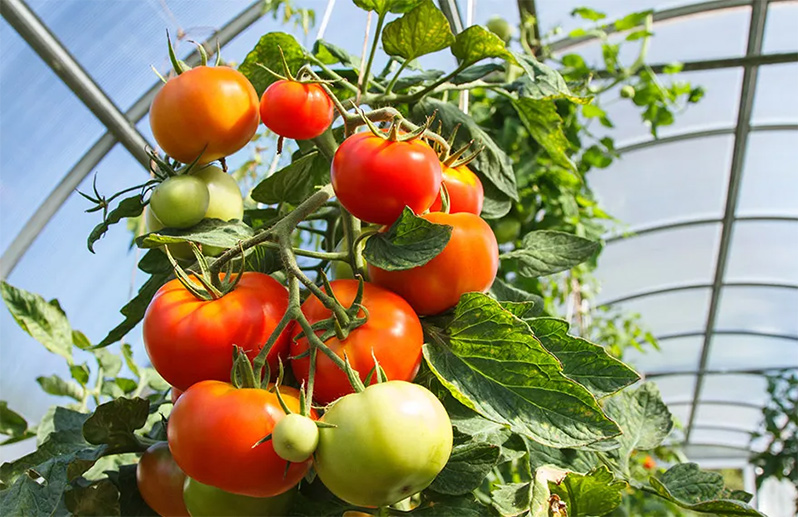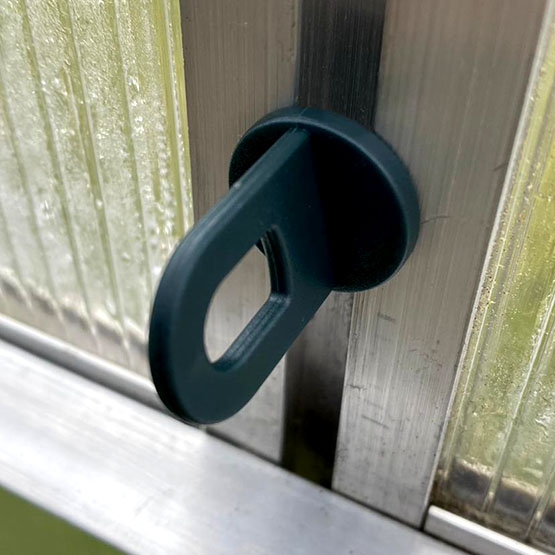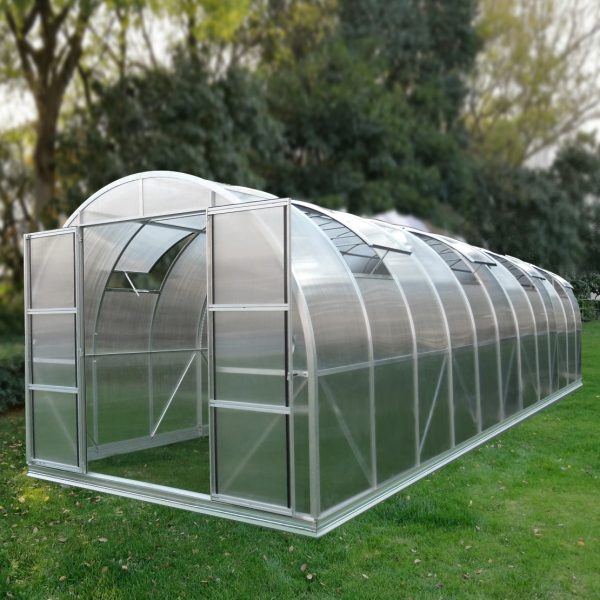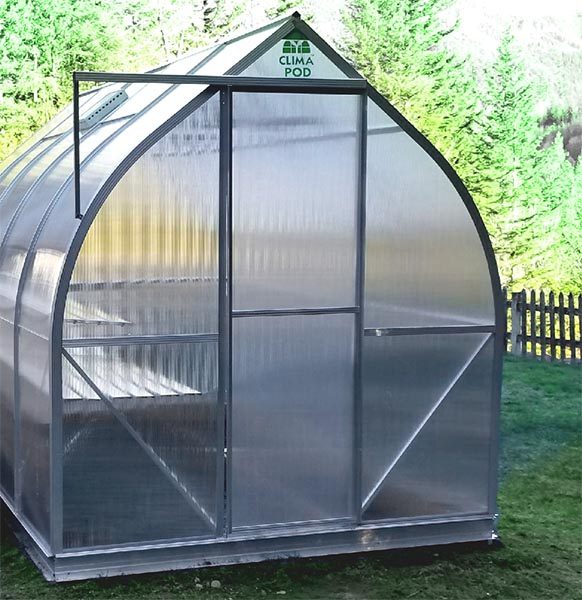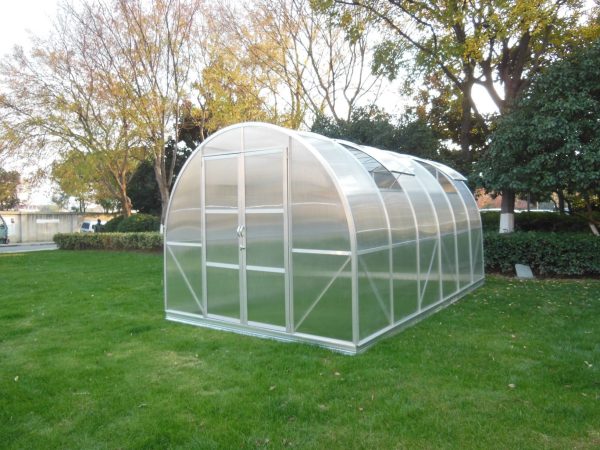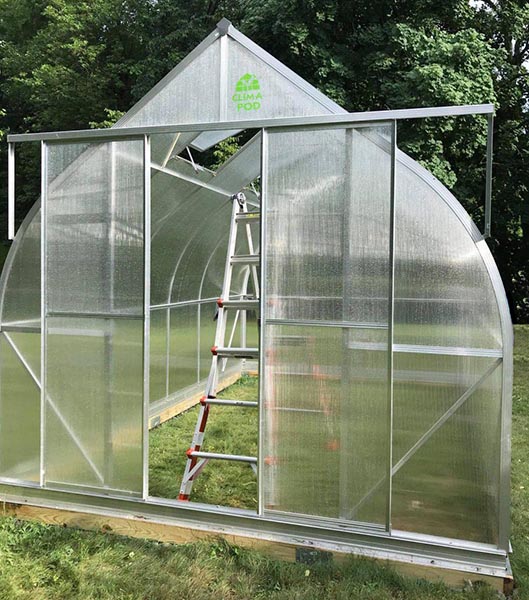The Ultimate Greenhouse Tomato Fertilizer Guide by ClimaPod! Tomatoes belong to heat-loving crops, therefore in the northern states they are grown in a polycarbonate greenhouses. A suitable microclimate is created inside for growing plants. But for full growth and development, it is important to provide the tomatoes with the necessary fertilizers inside the greenhouse.
What elements do tomatoes need?
For full growth, tomatoes need basic macroelements:
- nitrogen – growth of vegetative mass (stems, leaves);
- phosphorus – development of the root system, acceleration of flowering and fruit ripening, resistance to adverse conditions;
- potassium – formation of ovaries, bright color of fruits, pronounced taste, presentation, shelf life, disease resistance.
Microelements are also important for tomatoes:
- magnesium – formation of ovaries, fruit growth;
- zinc – active plant growth, ovary formation, large fruit size, early ripening, strengthening immunity;
- boron – productivity, formation of ovaries, large fruit sizes, saturation with sugars and vitamins, keeping quality;
- manganese – participation in photosynthesis, resistance to diseases (especially brown spot).
What fertilizers do greenhouse tomatoes need?
To get high yields, all types of fertilizing are necessary:
- Organic (compost, humus).
- Mineral (ammonium, potassium and calcium nitrate, potassium sulfate, potassium chloride, potassium salt, potassium magnesium, monophosphate, superphosphate, NPK fertilizers, urea).
- Organomineral (complex) – combine mineral supplements and humus.
- Additionally, anti-stress drugs, growth stimulants, root and fruit formation stimulants are recommended.
Feeding scheme for tomatoes by development phases
Tomatoes go through several stages in their development:
- vegetation – the bush increases its vegetative mass (stems, leaves);
- bloom;
- formation of ovaries;
- fruit filling and ripening.
At each of these stages, the composition of the greenhouse tomato should be different.
Before planting

Before planting tomato seedlings in a greenhouse, you should add fertilizer to the soil.
Several compositions for fertilizing are known (per square meter):
- a bucket of compost or humus, 2 cups of wood ash;
- 1 tablespoon each of ammonium nitrate or urea, potassium sulfate and superphosphate;
- 1 tablespoon of NPK fertilizers;
- a bucket of compost (humus), turf soil, peat, 0.5 kg of wood ash, 1 teaspoon of urea.
Please note! If the soil is heavy, then additionally add old sawdust, last year’s leaves, and chopped dried grass.
Some gardeners advise drenching the greenhouse soil with iodine solution (3 drops of iodine per 10 L of water) before planting seedlings. Although iodine is not one of the vital elements, it has a disinfecting effect and increases the survival rate of plants. You can also disinfect the soil with a solution of potassium permanganate (1 gram of potassium permanganate per bucket of hot water).
Tomato fertilizer after planting

Newly planted plants do not particularly need fertilizing, because all the necessary elements have already been added to the soil. Within a week, the seedlings will adapt and take root, which is why the growth of the above-ground part will stop.
To speed up rooting and help the plant grow a powerful root system, use special dr*ugs. As a “bonus”, they will strengthen the tomatoes, increase resistance to diseases, adverse weather conditions and stressful situations.
The leaves of planted plants are sprayed with a growth stimulator. The stimulants, in addition to growth hormones, include vitamins, amino acids, macro- and microelements.
Evidence of rooting is the appearance of new leaves. Many gardeners, noticing that the bush in the greenhouse has begun to actively grow, feed it with organic matter (nettle infusion, manure solution). At the same time, the plants acquire a beautiful appearance (the stems thicken, the leaves acquire a rich color and juicy appearance), but fruiting is delayed. It is even possible for tomatoes to become fattened: small fruits are formed on powerful stems covered with large leaves.
Greenhouse tomato fertilizer during flowering

Do not rush to fertilize when the first flowers appear. It’s better to wait for mass flowering.
In order for the ovaries to actively appear, tomatoes need potassium, which promotes the outflow of nutrients into rapidly growing fruits. But it should be taken into account that potassium “pulls” phosphorus, nitrogen and microelements with it, which is why the leaves become smaller and the stems become thinner. Therefore, it is necessary to apply complex fertilizers so that the plants receive not only potassium, but also other mineral elements.
You can use infusions of droppings or nettles, but they contain much less potassium than nitrogen. In addition, no one knows the exact ratio of the components (potassium, phosphorus, nitrogen). Therefore, it is better to give preference to ready-made mixtures sold in stores.
If they are not available, you can prepare a feeding mixture yourself by dissolving 20 grams of any potassium salt (except for chloride) and 10 grams of superphosphate and ammonium nitrate (or urea) in a bucket of water. Superphosphate is pre-diluted in hot water. It is recommended to add a glass of wood ash to the solution to enrich the composition with trace elements. The resulting volume (10 liters or 2.6 gallons) is calculated per 10 square feet (1 square meter) of area.
Another composition. Dissolve 1 tablespoon of potassium sulfate and 1 pint (half a liter) of bird droppings in 2.6 gallons (10 L) of water, add 1 pint (half a liter) of liquid mullein. Two pints (1 liter) of fertilizer is poured under one bush.
Additionally, foliar feeding is carried out with the solution of boric acid (2 grams per 2.6 gallons (10 L) of water). Process until the leaves are completely wetted. A solution of boric acid not only stimulates the formation of ovaries, but also increases the sweetness of the fruit.
During the entire growing season, you can add humate (1 teaspoon per 2.6 gallons (10 L) of water). A good result is provided by chicken manure diluted with water in a ratio of 1:2. The mixture must be infused for 4-5 days, and then diluted with water 10-20 times the volume.
To stimulate the ovaries, it is recommended to water greenhouse tomatoes with a solution of superphosphate (1 teaspoon per 2.6 gallons (10 L) of water). You can prepare fertilizer with 10 grams of boric acid (dissolved in hot water), 0.33 fl.oz.(10 ml) of iodine and one and 1 pint (0.5 L) of ash, diluted in 2.6 gallons (10 L) of water. This mixture contains many microelements, promotes the formation of ovaries, gives the fruits fleshiness and a pronounced taste.
Foliar feeding will show good results (consumption – 0.4 gallon (1.5 L) per square meter):
- 2 cups of wood ash are poured with 0.5 gallon (2 L) of hot water. The mixture is infused for two days and filtered. Add water to get 2.6 gallons (10 L) of infusion.
- 15 grams of magnesium sulfate are dissolved in 2.6 gallons (10 L) of water.
Tomato fertilizer after the ovaries appear
Feeding begins when most bushes have 2 clusters with ovaries. Use the same mixture (with potassium content) as for flowering.
Since the fruits form gradually, it is necessary to do 2-3 feedings (depending on the duration of the growing season).
Greenhouse tomato fertilizer during ripening

When some of the fruits are ripe, the rest are just set and filled. Therefore, they continue to apply fertilizers. Together with complex fertilizers, calcium is also added: 20 grams of calcium nitrate are dissolved in 2.6 gallons (10 L) of water. Calcium promotes the delivery of all other elements to the fruit (if it is lacking, other fertilizers will not be beneficial), and prevents the development of blossom end rot. Before flowering, calcium nitrate is applied at the root, and during fruiting, foliar feeding is carried out. It should be taken into account that fertilizers containing calcium are applied separately, since they form an insoluble precipitate in mixtures.
The last feeding in the greenhouse is carried out during the period of mass fruiting. Dissolve 2 tablespoons of superphosphate in 2.6 gallons (10 L) of water, add 1 tablespoon of liquid potassium humate. Two pints (1 liter) of fertilizer is poured under each tomato bush.
How often to fertilize tomatoes
The amount of fertilizing depends on the yield of the variety. High-yielding varieties, hung with tomato bunches, need frequent (every 7-10 days) fertilizing. For plants that produce no more than three clusters, two feedings per season are sufficient.
The need for fertilizer can also be judged by the condition of the plants. If the leaves are bright green and the stems are powerful, then the bushes are provided with everything they need. Nutritional deficiency is indicated by cessation of growth, fading of leaves, and slow formation of ovaries.
The effect of fertilizing appears after 7-10 days.
Signs of a lack of macro- and microelements
| Sign | What element is needed | What to feed |
|
Nitrogen | Urea solution (25 grams per 10 L of water), foliar feeding |
|
Potassium | Potassium sulfate (25 grams per 10 L of water) |
|
Phosphorus | Superphosphate (20 grams per 10 L of water), root or foliar feeding |
|
Calcium | Calcium nitrate, foliar feeding |
|
Zinc | Zinc sulfate, foliar feeding. Zinc sulfate – watering (3 grams per 10 square meters) |
|
Bor | Boric acid (2 grams per 10 L of water) |
|
Copper | Copper sulfate, foliar feeding Superphosphate with copper or pyrite cinders are scattered on the soil along the rows |
|
Sulfur | Potassium sulfate – watering (20 grams per 10 L of water) Magnesium sulfate (15 grams per 10 L of water), foliar feeding |
|
Iron | Iron chelate (5 grams per 10 L of water) |
|
Magnesium | Magnesium sulfate (15 grams per 10 L of water), foliar feeding |
|
Manganese | Potassium permanganate or manganese sulfate (2 grams per 10 L of water), foliar feeding |
Proper feeding of tomatoes throughout the entire growth period will help you get a bountiful and tasty harvest! You can buy a polycarbonate greenhouse for growing any variety of tomatoes at Climapod.com website. Favorable prices for all products!

